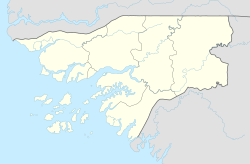Tabato
| Tabato | ||
|---|---|---|
|
|
||
| Coordinates | 12 ° 10 ′ N , 14 ° 39 ′ W | |
| Basic data | ||
| Country | Guinea-Bissau | |
| Leste | ||
| region | Bafatá | |
| ISO 3166-2 | GW-BA | |
| Residents | 223 (2009) | |
Tabato , also Tabatô , is a town in Guinea-Bissau . The rural village ( Tabanca ) has 223 inhabitants (as of 2009), most of them belonging to the Mandinka ethnic group.
Tabato belongs to the administrative sector of Bafatá in the Bafatá region of the same name and is 10 km from Bafatá.
The village is known for its traditional mandinga instruments and is considered a cultural attraction in the region for Guinea-Bissau's tourism, which is only slowly developing.
history
The area in which the village is located was inhabited exclusively by the Fulbe ( Portuguese : Fula ). After the fall of the Kaabu empire in 1866, the Mandinka (Portuguese: Mandinga ) increasingly moved to this area in front of the advancing Fulan groups of the Islamic allies Fouta Djallon , Fouta Toro and Massina . Mamadu Alfa, the local Fulbe- Régulo ( traditional mayor ), left part of his domain to the incoming Mandinga in 1870, so that they did not have to move any further and founded their Tabanca (rural village) Tabato, which still exists today .
Balafon

In 1870 the Mandingas brought the xylophone- like balafon with them to Tabato, which is an essential part of everyday culture in the village to this day and is made from local wood by special balafon constructors who only receive permission to make balafons through a solemn rite. Every child in Tabato learns to play the balafon.
In the early 1990s, the Canadian ethnomusicologist Sylvain Panneton published a study on the Tabato balafon in the journal Soronda . Then the tabato balafon player Umar traveled to Montreal and taught the balafon at a university there for nine months. Umar is the younger brother of Tcherno Djabaté, a balafon player in Tabato who has performed in China and Korea. Tcherno is the son of the important balafon player Djali Ba Koli Djabaté, whose father Bunun Ka Djabaté was honored for his balafon playing at the 1940 colonial exhibition in Lisbon.
Movie
The Angolan-Portuguese director João Viana shot the short film Tabatô and the feature film A Batalha de Tabatô (Portuguese for: "The Battle of Tabatô") in Tabato in 2013 . The films ran a. a. at the Berlinale 2013 , where A Batalha de Tabatô received an Honorable Mention in the “First Feature” category and Tabatô received the DAAD Short Film Award. He was also shown at the Chicago International Film Festival and the Doclisboa and won some awards.
The short film portrays the village consisting only of musicians in the middle of the colonial war and civil unrest of Guinea-Bissau, which is considered hopelessly underdeveloped, but already knew an advanced culture 4500 years ago, when Europe was still very far away.
In his feature film, Viana then develops the theory that modern culture does not originate in Europe but in this region. In addition, he wanted to make a positive film about Guinea-Bissau, from which only very rarely and exclusively reports on crises and conflicts. In discussions about his work, the director said that the Guinea-Bissauers will achieve their own peace, and it will not be possible with the help of the UN or Portugal.
In 2014, the film Água para Tabatô (Portuguese for: "Water to Tabatô") was released, which shows a dramatic scene on a boat trip by people between Tabatô and Bolama .
Sons and daughters of the place
- Kimi Djabate (* 1975), Afrobeat musician now living in Lisbon
Individual evidence
- ↑ Inhabitants by region, sector and town by gender, 2009 census (p. 68), PDF access from the INE National Statistics Office of January 23, 2018
- ↑ Joana Petrolho, Marta Rosa: À Descoberta da Guiné-Bissau . , Afectos com Letras / EU, Pombal 2015, ISBN 978-989-20-6252-5 , p. 6 and p. 76
- ↑ a b TABATO, A TABANCA DOS DJIDIUS - “Tabato, the village of Djidius” , article from June 24, 2016 on the Guinea-Bissau music portal www.vozdaguine.com, accessed on January 23, 2018
- ^ List of awards for the film in the Internet Movie Database , accessed January 23, 2018
- ↑ Aldeia guineense de Tabatô está em destaque na Berlinale - "Guinea-Bissau village Tabatô presented at the Berlinale" , article from February 14, 2013 of the Portuguese-language Deutsche Welle , accessed on January 23, 2018
- ↑ Website on Água para Tabatô at the Figueira Film Art Festival 2017, accessed on January 23, 2018
- ↑ Summary of Água para Tabatô in the Internet Movie Database, accessed on January 23, 2018
